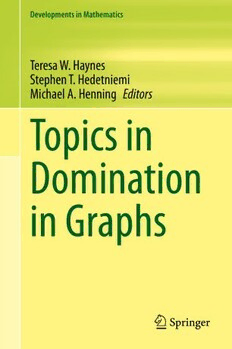
Topics in Domination in Graphs PDF
Preview Topics in Domination in Graphs
Developments in Mathematics Teresa W. Haynes Stephen T. Hedetniemi Michael A. Henning Editors Topics in Domination in Graphs Developments in Mathematics Volume 64 SeriesEditors KrishnaswamiAlladi,DepartmentofMathematics,UniversityofFlorida, Gainesville,FL,USA PhamHuuTiep,DepartmentofMathematics,RutgersUniversity,Piscataway,NJ, USA LoringW.Tu,DepartmentofMathematics,TuftsUniversity,Medford,MA,USA AimsandScope The Developments in Mathematics (DEVM) book series is devoted to publishing well-writtenmonographswithinthebroadspectrumofpureandappliedmathemat- ics.Ideally,eachbookshouldbeself-containedandfairlycomprehensiveintreating a particular subject. Topics in the forefront of mathematical research that present new results and/or a unique and engaging approach with a potential relationship to other fields are most welcome. High-quality edited volumes conveying current state-of-the-art research will occasionally also be considered for publication. The DEVMseriesappealstoavarietyofaudiencesincludingresearchers,postdocs,and advancedgraduatestudents. Moreinformationaboutthisseriesathttp://www.springer.com/series/5834 Teresa W. Haynes • Stephen T. Hedetniemi Michael A. Henning Editors Topics in Domination in Graphs Editors TeresaW.Haynes StephenT.Hedetniemi DepartmentofMathematicsandStatistics SchoolofComputing EastTennesseeStateUniversity ClemsonUniversity JohnsonCity,TN,USA Clemson,SC,USA DepartmentofMathematicsandApplied MichaelA.Henning Mathematics DepartmentofMathematicsandApplied UniversityofJohannesburg Mathematics Johannesburg,SouthAfrica UniversityofJohannesburg Johannesburg,SouthAfrica ISSN1389-2177 ISSN2197-795X (electronic) DevelopmentsinMathematics ISBN978-3-030-51116-6 ISBN978-3-030-51117-3 (eBook) https://doi.org/10.1007/978-3-030-51117-3 ©SpringerNatureSwitzerlandAG2020 Thisworkissubjecttocopyright.AllrightsarereservedbythePublisher,whetherthewholeorpartof thematerialisconcerned,specificallytherightsoftranslation,reprinting,reuseofillustrations,recitation, broadcasting,reproductiononmicrofilmsorinanyotherphysicalway,andtransmissionorinformation storageandretrieval,electronicadaptation,computersoftware,orbysimilarordissimilarmethodology nowknownorhereafterdeveloped. Theuseofgeneraldescriptivenames,registerednames,trademarks,servicemarks,etc.inthispublication doesnotimply,evenintheabsenceofaspecificstatement,thatsuchnamesareexemptfromtherelevant protectivelawsandregulationsandthereforefreeforgeneraluse. Thepublisher,theauthors,andtheeditorsaresafetoassumethattheadviceandinformationinthisbook arebelievedtobetrueandaccurateatthedateofpublication.Neitherthepublishernortheauthorsor theeditorsgiveawarranty,expressedorimplied,withrespecttothematerialcontainedhereinorforany errorsoromissionsthatmayhavebeenmade.Thepublisherremainsneutralwithregardtojurisdictional claimsinpublishedmapsandinstitutionalaffiliations. ThisSpringerimprintispublishedbytheregisteredcompanySpringerNatureSwitzerlandAG Theregisteredcompanyaddressis:Gewerbestrasse11,6330Cham,Switzerland Preface Whileconceptsrelatedtodominationingraphscanbetracedbacktothemid-1800s in connection with various chessboard problems, domination was first defined as a graph-theoretical concept in 1958. Domination in graphs experienced rapid growthsinceitsintroductionresultinginover1200paperspublishedondomination in graphs by the late 1990s. Noting the need for a comprehensive survey of the literature on domination in graphs, in 1998 Haynes, Hedetniemi, and Slater published the first two books on domination, Fundamentals of Domination in GraphsandDominationinGraphs:AdvancedTopics.WerefertotheseasBooksI andII. Theexplosivegrowthhascontinuedandtodaymorethan4000papershavebeen publishedondominationingraphs,andthematerialinBooksIandIIismorethan 20 years old. Thus, the authors think it is time for an update on the developments indominationtheorysince1998.Wealsowanttogiveacomprehensivetreatment ofthemajortopicsindomination.Thiscoverageofdominationincludingboththe fundamentalmajorresultsandupdateswillbeintheformofthreebooks,whichwe shallcallBooksIII,IV,andV. Book III, Domination in Graphs: Core Concepts, is written by the authors and concentrates, as the title suggests, on the three main types of domination in graphs: domination, independent domination, and total domination. It contains major results on these basic domination numbers, including proofs of selected results that illustrate many of the proof techniques that are used in domination theory. For the companion books, Books IV and V, we invited leading researchers indominationtocontributechapters. Book V has three parts, the first of which focuses on several domination- related concepts. The second part focuses on domination in (i) hypergraphs, (ii) chessboards, and (iii) digraphs and tournaments. The third part focuses on the developmentofalgorithmsandcomplexityofdominationparameters. Thepresentvolume,BookIV,concentratesonmajordominationparametersthat were not covered in Book III. Although well over 70 types of dominating sets have been defined, Book IV focuses on the primary ones that have received the most attention in the literature. In particular, the chapters include such parameters v vi Preface as paired domination, connected domination, restrained domination, domination functions,Romandomination,andpowerdomination. The authors of Book IV provide a survey of known results with a sampling of prooftechniquesforeachparameter.Toavoidexcessiverepetitionofdefinitionsand notations,Chapter1providesaglossaryofcommonlyusedtermsandChapter gives anoverviewofmodelsofdominationfromwhichtheparametersaredefined. This book is intended as a reference resource for researchers and is written to reach the following audience: First, the audience includes the established researchersinthefieldofdominationwhowantanupdatedcomprehensivecoverage on domination. Second are the researchers in graph theory and graduate students whowishtobecomeacquaintedwithtopicsindominationincludingmajoraccom- plishmentsinthefieldandprooftechniquesused.Weanticipatethatitcouldalsobe usedinaseminarcourseondominationingraphs. Wewishtothanktheauthorswhocontributedchapterstothisbookaswellasthe reviewersofthechapters. JohnsonCity,TN,USA TeresaW.Haynes Clemson,SC,USA StephenT.Hedetniemi Johannesburg,SouthAfrica MichaelA.Henning Contents GlossaryofCommonTerms .................................................... 1 TeresaW.Haynes,StephenT.Hedetniemi,andMichaelA.Henning ModelsofDominationinGraphs............................................... 13 TeresaW.Haynes,StephenT.Hedetniemi,andMichaelA.Henning PairedDominationinGraphs .................................................. 31 WyattJ.Desormeaux,TeresaW.Haynes,andMichaelA.Henning ConnectedDomination .......................................................... 79 MustaphaChellaliandOdileFavaron RestrainedandTotalRestrainedDominationinGraphs.................... 129 JohannesH.HattinghandErnstJ.Joubert MultipleDomination............................................................. 151 AdrianaHansbergandLutzVolkmann DistanceDominationinGraphs................................................ 205 MichaelA.Henning Locating-DominationandIdentification ...................................... 251 AntoineLobstein,OlivierHudry,andIrèneCharon SignedandMinusDominatingFunctionsinGraphs ........................ 301 LiyingKangandErfangShan FractionalDominatingParameters............................................ 349 WayneGoddardandMichaelA.Henning RomanDominationinGraphs.................................................. 365 MustaphaChellali,NaderJafariRad,SeyedMahmoudSheikholeslami, andLutzVolkmann RainbowDominationinGraphs................................................ 411 BoštjanBrešar vii viii Contents EternalandSecureDominationinGraphs.................................... 445 WilliamF.KlostermeyerandC.M.Mynhardt StratifiedDomination............................................................ 479 GaryChartrandandPingZhang GlobalDomination............................................................... 497 RobertC.Brigham,JulieR.Carrington,andRonaldD.Dutton PowerDominationinGraphs................................................... 521 PaulDorbec Glossary of Common Terms TeresaW.Haynes,StephenT.Hedetniemi,andMichaelA.Henning 1 Introduction Itisdifficulttosaywhenthestudyofdominationingraphsbegan,butforthesakeof thisglossaryletussaythatitbeganin1962withthepublicationbyOysteinOre’s book Theory of Graphs [15]. In Chapter 13 Dominating Sets, Covering Sets and IndependentSetsof [15],weseeforthefirsttimethenamedominatingset,defined asfollows:“AsubsetDofV isadominatingsetforGwheneveryvertexnotinD istheendpointofsomeedgefromavertexinD.”Orethendefinesthedomination number, denoted δ(G), of a graph G, as “the smallest number of vertices in any minimaldominatingset.”So,atthispoint,andforthefirsttime,dominationhasa “name”anda“number.” Of course, prior to this Claude Berge [3], in his book Theory of Graphs and its Applications, which was first published in France in 1958 by Dunod, Paris, had previously defined the same concept, but had, in Chapter 4 The Fundamental T.W.Haynes((cid:2)) DepartmentofMathematicsandStatistics,EastTennesseeStateUniversity,JohnsonCity,TN 37614-0002,USA DepartmentofMathematicsandAppliedMathematics,UniversityofJohannesburg,Auckland Park2006,SouthAfrica e-mail:[email protected] S.T.Hedetniemi ProfessorEmeritus:SchoolofComputing,ClemsonUniversity,Clemson,SC29634,USA e-mail:[email protected] M.A.Henning DepartmentofMathematicsandAppliedMathematics,UniversityofJohannesburg,Auckland Park2006,SouthAfrica e-mail:[email protected] ©SpringerNatureSwitzerlandAG2020 1 T.W.Haynesetal.(eds.),TopicsinDominationinGraphs,Developmentsin Mathematics64,https://doi.org/10.1007/978-3-030-51117-3_1 2 T.W.Haynesetal. Numbers of the Theory of Graphs of [3], given it the name “the coefficient of externalstability.” Before Berge, Dénes König, in his 1936 book Theorie der Endlichen und Unendlichen Graphen [13], had defined essentially the same concept, but in VII Kapitel,BasisproblemfürgerichteteGraphen,Königgaveitthename“punktbasis,” whichwewouldtodaysayisanindependentdominatingset. AndevenbeforeKönig,inthebooksbyDudeneyin1908 [8]andW.W.Rouse Ballin1905 [2],onecanfindtheconceptsofdomination,independentdomination, and total domination discussed in connection with various chessboard problems. AnditwasBallwho,inturn,creditedsuchpeopleasW.Ahrensin1910 [1],C.F. de Jaenisch in 1862 [7], Franz Nauck in 1850 [14], and Max Bezzel in 1848 [4] fortheircontributionstothesetypesofchessboardproblemsinvolvingdominating setsofchesspieces. ButitwasOrewhogavethenamedominationandthisnametookroot.Notlong thereafter,CockayneandHedetniemi [6]gavethenotationγ(G)forthedomination numberofagraph,andthisalsotookrootandisthenotationadoptedhere. Sincethesubsequentchaptersinthisbookwilldealwithdominationparameters, there will be much overlap in the terminology and notation used. One purpose of this chapter is to present definitions common to many of the chapters in order to prevent termsbeingdefined repeatedly andtoavoidotherredundancy. Also,since graph theoryterminology and notationsometimes vary,inthisglossaryweclarify theterminologythatwillbeadoptedinsubsequentchapters. We proceed as follows. In Section 2.1, we present basic graph theory defi- nitions. We discuss common types of graphs in Section 2.2. Some fundamental graph constructions are given in Section 2.3. In Section 3.1 and Section 3.2, we presentparametersrelatedtoconnectivityanddistanceingraphs,respectively.The covering,packing,independence,andmatchingnumbersaredefinedinSection3.3. Finally in Section 3.4, we define selected domination-type parameters that will occurfrequentlythroughoutthebook. For more details and terminology, the reader is referred to the two books FundamentalsofDominationinGraphs [10]andDominationinGraphs,Advanced Topics [11] written and edited by Haynes, Hedetniemi, and Slater, and the book TotalDominationinGraphsbyHenningandYeo [12].Anannotatedglossary,from which many of the definitions in this chapter are taken, was produced by Gera, Haynes,Hedetniemi,andHenningin2018 [9]. 2 BasicTerminology Inthissection,wegivebasicdefinitions,commontypesofgraphs,andfundamental graphconstructions.
